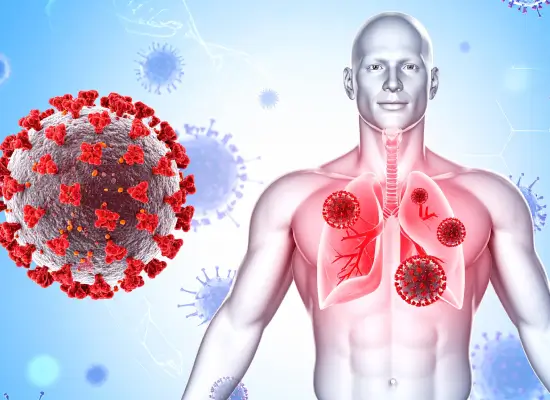On the contrary, asthma and COPD are diseases of the airways, but ILD is associated with lung scarring and stiffness, despite the fact that the symptoms are essentially the same.

- Introduction
- What is Interstitial Lung Disease (ILD)?
- Types of Interstitial Lung Disease
- Causes of Interstitial Lung Disease
- Symptoms of Interstitial Lung Disease
- Diagnosis of Interstitial Lung Disease
- Treatment for Interstitial Lung Disease
- How Can I Prevent Interstitial Lung Disease?
- Why Choose Gleneagles Hospitals for Interstitial Lung Disease?
- Conclusion
Introduction
Interstitial Lung Disease is not a single pathological condition, but a collection of different disorders which cause lung inflammation and scarring. Such harm to the lungs makes it difficult for oxygen to flow from the lungs to the blood, causing breathlessness that gradually becomes more severe. However, ILD is still a fatal disease; the diagnosis in the early stages, accurate treatment, and change of lifestyle can not only make life better but also reverse the disease.
What is Interstitial Lung Disease (ILD)?
The term interstitial denotes the minute structures and the area around the air sacs (alveoli) in the lungs. Oxygen moves very easily through these air sacs into the blood in a healthy lung. But in Interstitial Lung Disease (ILD), the interstitial tissue is either inflamed, thickened, or scarred (fibrosis). With this, the lungs become less flexible and consequently, they are not able to take in as much air as before, which is the reason why breathlessness and low oxygen levels occur.
ILD can originate from a diverse range of situations, such as a patient's lifestyle of dealing with hazardous substances for a long time, having an autoimmune disease, or even being caused by a factor that remains unidentified. The effect can vary from mild breathing discomfort to a severe, progressive disorder that may need oxygen therapy or a lung transplant.
Types of Interstitial Lung Disease
All forms of ILD cause the interstitium to thicken. This thickening may be due to inflammation, scarring, or fluid accumulation. Some types of the disease which may be common are:
- Idiopathic Pulmonary Fibrosis (IPF): A non-reversible, progressive disease where lung fibrosis happens with no determined cause.
- Hypersensitivity Pneumonitis: A disease that is the result of repeated breathing of allergens such as the spores of moulds, the feathers of birds, or the dust. •
- Autoimmune-Related ILD: Diseases like rheumatoid arthritis, lupus, or scleroderma may eventually bring about scarring in the lungs.
- Sarcoidosis: An inflammatory condition where tiny clusters of cells (granulomas) form in the lungs and other organs.
- Occupational ILD: Prolonged exposure to asbestos, silica dust, or coal dust can lead to scarring of lung tissue.
Each type differs in cause and progression, but the common thread is damage to the lung’s interstitial tissue.

Causes of Interstitial Lung Disease
ILD can develop for different reasons. Sometimes the cause of ILD is very obvious, while it remains unknown in other cases. The reasons can generally be categorised like this-
- Occupational and Environmental Exposures: Inhaling and marinating the lungs with dangerous dust (asbestos, silica, coal dust), gases, fumes, or mould spores may cause very serious harm to the lungs.
- Autoimmune and Connective Tissue Diseases: The probability of connective tissue disease-associated ILD is higher in patients suffering from autoimmune diseases, like systemic sclerosis, rheumatoid arthritis, & systemic lupus erythematosus.
- Medications and Radiation: Lung tissue may be affected negatively by some drugs (e.g. chemotherapy, heart medicines, or antibiotics) and also by radiation therapy to the chest.
- Genetic Factors: In some families, ILD appears to be inherited from generation to generation, causing this disease to be considered genetic.
- Idiopathic Causes: Diseases due to unknown reasons, like idiopathic pulmonary fibrosis, are called "idiopathic" in addition to the capability of having no clear cause found.
Your health matters – get expert advice today.
Symptoms of Interstitial Lung Disease
Shortness of breath is the major indication of interstitial lung disease. It is possible that you will detect that you are breathing more rapidly or more difficultly, or that the breaths you take are shallow. Common ones include:
- Shortness of Breath (Dyspnea): Initially, this symptom may only be present during physical activity, such as climbing stairs, but it may also occur at rest over time.
- Dry, Persistent Cough: The cough may be continuous and very irritating; however, it is non-productive in nature.
- Fatigue: The constant fight for air may leave patients extremely exhausted. • Unexplained Weight Loss: A lot of patients also undergo slow but steady weight loss.
- Clubbing of Fingers: The distal parts of the fingers or toes may look swollen or like they have a larger diameter.
Despite the fact that these symptoms closely resemble those of asthma, COPD, or other lung diseases, ILD may still be misdiagnosed a lot in its early stages. The severity of the symptoms may vary, and they may be similar to those of other respiratory or health conditions. If you experience shortness of breath or any other unusual symptoms, consult your doctor. You can receive therapy for the inflammation and scarring if interstitial lung disease is the root cause of your symptoms.
Diagnosis of Interstitial Lung Disease
Doctors follow a detailed and stepwise approach in diagnosing ILD. They usually begin by inquiring about your symptoms, lifestyle, workplace environment, and family medical history. Diagnostic tools include:
- Physical Examination: Listening to the lungs for “crackling” sounds during breathing.
- Imaging Tests: High-resolution CT scans and X-rays can be used to obtain images of your lungs.
- Pulmonary Function Tests (PFTs): Pulmonary function tests, or PFTs, are usually breathing tests, and they determine how well your lungs are working.
- Blood Tests: Your concerned doctor will do a blood test on a sample drawn from your arm to check for any indications of illnesses that may cause ILD.
- Bronchoscopy: A bronchoscope is a narrow tube which is inserted into the nose or mouth and then through the windpipe to get a view of the airways.
- Biopsy. Your doctor will send a small lung tissue sample taken from the patient back to the lab, where it will be examined under a microscope to help in identifying the type of ILD.
Accurate diagnosis is critical because treatment strategies vary depending on the type and cause of ILD.
Treatment for Interstitial Lung Disease
Interstitial lung disease is not curable. Therapy for ILD primarily targets the source of the disease and makes your symptoms better. The treatment possibilities might be:
Medications:
• Anti-inflammatory drugs such as corticosteroids.
• Anti-fibrotic drugs may slow the progress of alveolar scarring.
• Immunosuppressants are used to treat ILDs associated with autoimmune conditions.
Oxygen Therapy: Extra oxygen will be given if the blood and/or tissues do not get enough of it. The oxygen is provided by a mask or through a tube in the nose.
Pulmonary Rehabilitation: Breathing exercises and physical therapy can strengthen your lungs and make breathing easier.
Lifestyle Modifications: By giving up smoking, eating healthily, performing breathing exercises, and steering clear of environmental irritants.
Lung Transplant: Such intervention may be effective in terminal cases where lung function is severely compromised.
How Can I Prevent Interstitial Lung Disease?
Most interstitial lung diseases are not preventable, but you can lower your risk of ILD by maintaining good lung health and managing the health problems that you have.:
- Wear protective equipment at work: If your work involves exposure to asbestos, metal dust, chemicals, or other harmful particles, wear a respirator or protective mask.
- Limit exposure to allergens: Use a mask when dealing with hay, grain, bird droppings, feathers, or working near heating and cooling systems that may trigger your symptoms.
- Manage existing illnesses: If you have conditions like sarcoidosis or connective tissue diseases, follow your doctor's prescription to control flare-ups and minimise lung damage.
- Quit smoking: If you smoke, get support to quit, as smoking accelerates lung injury and causes scarring to progress rapidly.
Taking these measures not only helps protect your lungs but also slows down the risk of ILD occurrence or progression.
Why Choose Gleneagles Hospitals for Interstitial Lung Disease?
Gleneagles Hospitals is a trusted centre for advanced lung care, offering expert diagnosis and treatment for patients with Interstitial Lung Disease. Here’s why patients rely on us:
- Specialised Pulmonology Team: It is a team of doctors working under the mentorship of our chief pulmonologist, who specialises in the most challenging cases of ILD to treat.
- Advanced Diagnostic Facilities: These facilities offer diagnostic and biopsy services for the accurate detection of disorders, including high-resolution tomography and lung function tests.
- Personalised Care Plans: The customised therapies are facilitated by the use of the latest anti-fibrotic drugs, immunotherapy, and rehabilitation programs.
- Comprehensive Support: The pulmonary rehabilitation, oxygen therapy, and lifestyle modifications provided constitute long-term care.
- Integrated Multidisciplinary Approach: Collaboration across cardiology, rheumatology, and critical care to manage ILD complications effectively.
Gleneagles Hospitals always aim to enhance pulmonary efficiency, slow the progression of the disorder, and improve the quality of life for patients.
Conclusion
A complex collection of conditions known as interstitial lung disease causes the lungs to behave in a way that makes breathing more difficult. Although it may not always be curable, the disease can be detected early and managed appropriately through a correct treatment plan and lifestyle modifications. Fighting ILD with an alert mind and proactive healthcare administration is still the best method of controlling the disease.
Experience: 15 Years
Heart and Lung Transplant,Pulmonology,Interventional Pulmonology and Sleep Medicine
Bengaluru, KengeriExperience: 14 Years
Pulmonology,Interventional Pulmonology and Sleep Medicine
Hyderabad, Lakdi-Ka-PulExperience: 5 Years
Pulmonology,Interventional Pulmonology and Sleep Medicine
Hyderabad, Lakdi-Ka-Pul
Frequently Asked Questions
At this moment, there is no cure for the majority of ILD cases; however, treatment may relieve symptoms and slow down the progression of the disease.
The individuals with smoking as one of their habits, long-term exposure to dust or asbestos, autoimmune diseases, or a family history of respiratory diseases are more susceptible to indirect lung diseases.
Yes. Mild exercise and pulmonary rehabilitation, when done under medical supervision, can stimulate the lung's endurance and effectiveness.




















